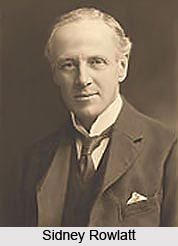 The Rowlatt Committee was primarily a Sedition Committee that was appointed by the British Empire in India in the year 1918. An English judge named Mr. Justice Sidney Rowlatt served as its president. The objective of the Rowlatt committee was to assess political violence and terrorism in the country, particularly in Punjab and Bengal. It also evaluated the impact of the rebellion and the associations with the Bolsheviks in Russia and the German government. The committee was established during the culmination of the First World War, when the revolutionary movements in India was particularly active and had attained adequate success, momentum and potency. Moreover, the movement received immense support from Germany which intended to weaken and subvert the British Government of India.
The Rowlatt Committee was primarily a Sedition Committee that was appointed by the British Empire in India in the year 1918. An English judge named Mr. Justice Sidney Rowlatt served as its president. The objective of the Rowlatt committee was to assess political violence and terrorism in the country, particularly in Punjab and Bengal. It also evaluated the impact of the rebellion and the associations with the Bolsheviks in Russia and the German government. The committee was established during the culmination of the First World War, when the revolutionary movements in India was particularly active and had attained adequate success, momentum and potency. Moreover, the movement received immense support from Germany which intended to weaken and subvert the British Government of India.
These included financing and supporting Indian seditionist organisations in the United States of America and Germany as well as a decline and deterioration in the political scenario in the adjacent region of Afghanistan which followed a diplomatic task that had tried to rally the Amir of Afghanistan against the British administration in India. The Provisional Government of India that was set up in Afghanistan after the mission also made several attempts to establish contacts with the Bolsheviks. Moreover the committee was instituted due to the emerging labour and civil unrest in nation during the post-war recession.
The evidence that was presented before the Rowlatt committee verified the German link, even though any decisive evidence was not found for a major contribution or threat from the Bolsheviks. As a result of recommendations of the Rowlatt committee, the Rowlatt Act, which was an expansion of the Defence of India Act 1915, was imposed in reaction to the threat in Bengal and Punjab. The Rowlatt Act had a considerable impact on the political scenario in the country, which gave rise to the political movement led by Mahatma Gandhi that dominated the Indian freedom struggle. It was also known as the Black Act, which vested the Viceroy`s government with unexpected authority to suppress sedition by scrutinizing the press, arresting the independence activists without trial and detaining any person suspected of treason or sedition without warrant. As a result, a nationwide protest took place through cessation of work or Hartal.
On 13th April 1919, the protests, which were provoked by the acts, ended in the Jallianwala Bagh massacre in Amritsar, Punjab. Brigadier General Reginald Dyer, a British Military Commander, blocked the key entrance to the Jallianwallah Bagh, which was a walled in courtyard in Amritsar, and commanded the British troops to shoot the unsuspecting and unarmed people who were present there in defiance of a ban.
Members of the Rowlatt Committee
The chronology of the members of the Rowlatt Committee is mentioned as follows-
* Sir Sidney Rowlatt (President)
* JDV Hodge (Secretary, a member of Bengal civil service)
* Basil Scott (Member, Chief Justice of the Bombay High Court])
* C. V. Kumaraswami Sastri (Member, Judge of Madras High Court)
* Verney Lovett (Member, Member of Board of Revenue for United Provinces)
* P. C. Mitter (Member, Member of Bengal Legislative Council)



















